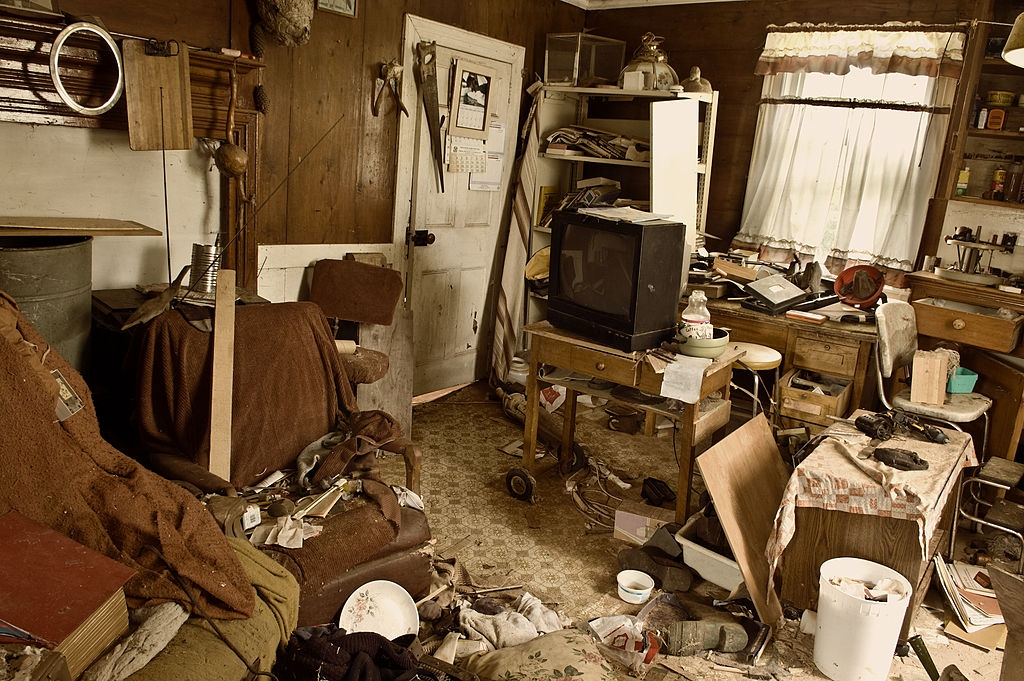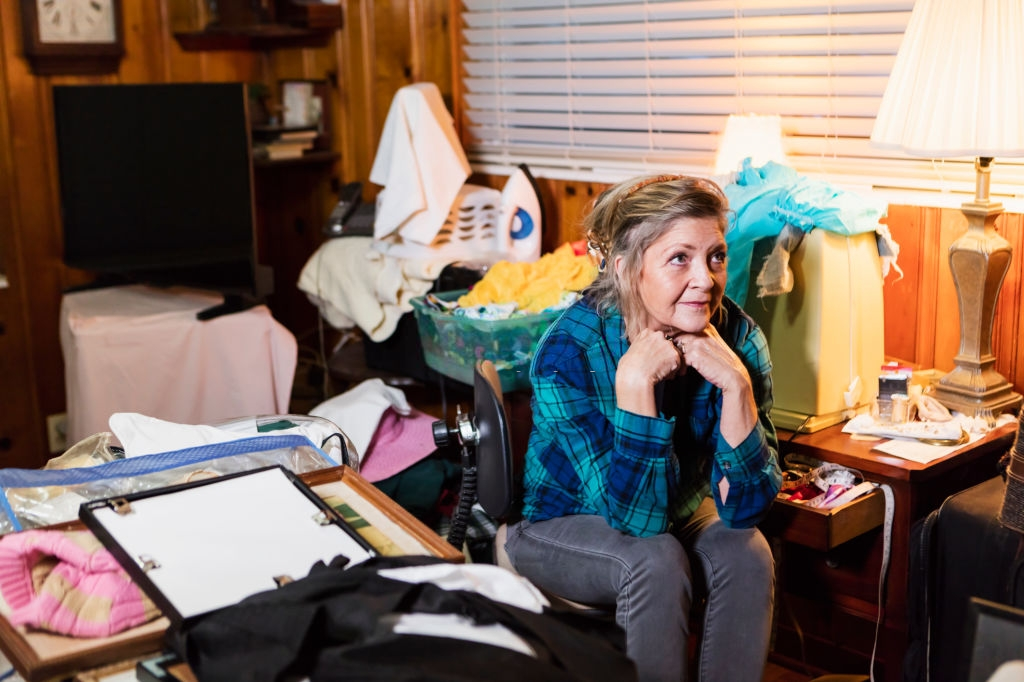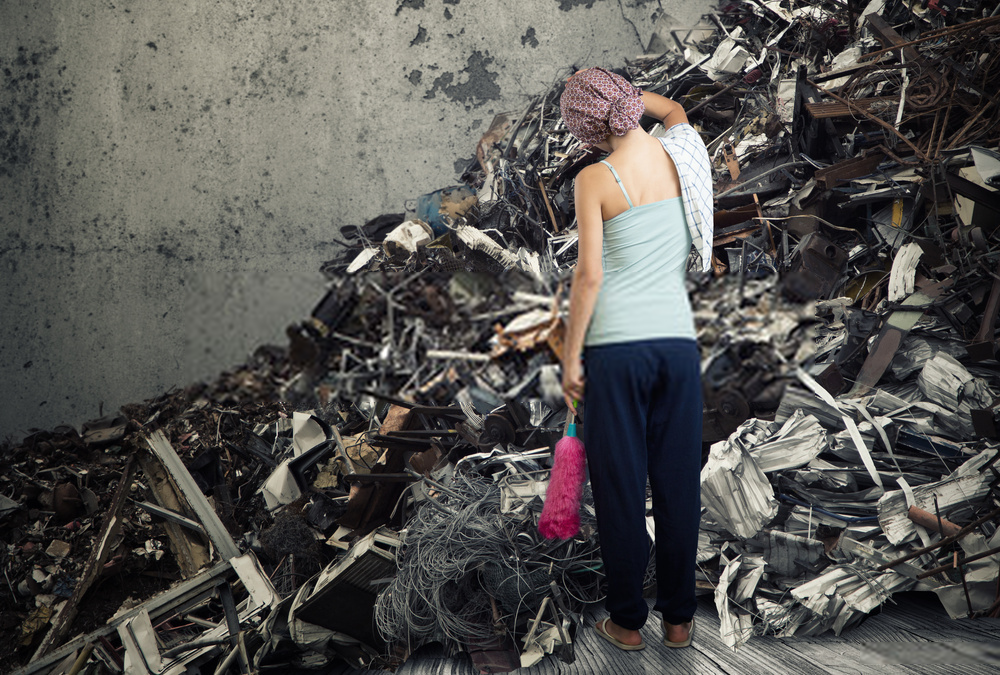Dealing with hoarding is difficult for everyone involved. If a person has started to hoard belongings in their home, they may be unwilling to accept they have a problem, even if their possessions are taking over their life and making their living area unsafe. This delicate situation requires sensitive treatment and the right approach in order to avoid causing more harm than good.
The first step is realizing when hoarding has become a problem. Many people have clutter in their homes and hang on to possessions longer than necessary. However sometimes that sentimental attachment to an old toy or item of clothing, or sense of “I might need it one day,” can get out of control, and suddenly everything seems important and worth keeping.
What is hoarding?
According to the Mayo Clinic, a hoarding disorder is classed as a “persistent difficulty discarding or parting with possessions because of a perceived need to save them.” Many hoarders collect possessions that most people would consider worthless. Old newspapers, plastic bags, trash, and clothing are all common items that hoarders typically collect. However unlike true collections, which are usually carefully curated and stored, hoarded items are often kept in disarray and can spill over into the hoarder’s living space.
The difference between clutter and hoarding
Clutter is a common complaint most people have about their homes. That stack of old magazines beside the sofa, or a few more shirts than comfortably fit inside the closet, are typical for many of us. However there are a few ways to tell when clutter has gone too far and turned into hoarding.
It’s important to address hoarding as soon as possible, because it can quickly get out of hand and create an unsafe living environment. Clean homes are healthy homes, and hoarders’ homes can become magnets for pests and bacteria.
Often the first sign of hoarding is the inability to use areas of the home in their intended way. If a guest can’t sit on your sofa because there are papers piled on top of it, or you can barely climb the stairs because there are items stacked on each one, it’s time to consider addressing the problem. As hoarding behavior continues, the accumulation of possessions only gets worse, until whole rooms are inaccessible.
Generally speaking, if your home is a bit messy but you can tidy it up when visitors arrive, it might be time to declutter and reevaluate your relationship with your possessions, but it doesn’t fall into the category of hoarding.
What are the reasons for hoarding?
Hoarding is a type of anxiety disorder that was named a distinct mental illness in 2013. Despite its prevalence in common culture on TV shows such as Hoarders, only about 2 to 5 percent of the population have been diagnosed with a hoarding disorder.
What causes hoarding can be anything from generalized anxiety to a traumatic event. Hoarders keep possessions for the same reasons we all do—because they have a sentimental attachment, or because they’re considered useful or necessary. With hoarders, however, that attachment or feeling of need can become misplaced.
The fear of not having something when it’s needed can also trigger hoarding behavior. This can be caused by something in the person’s past, such as not having enough food or possessions in the past, or experiencing a single trauma such as a house fire. Sometimes, however, there is no inciting incident or event that causes hoarding behavior.
The 5 levels of hoarding
Hoarding is often classified in five levels, or stages, depending on how extreme it is. These are:
Stage 1: Homes are often considered heavily cluttered rather than symptomatic of hoarding. All rooms and areas are passable and the house is still clean and safe.
Stage 2: Possessions are starting to take over the home. One or two rooms might be difficult to navigate, and there may be bad odors present. Mildew may be observed in the kitchen and bathroom, pet waste may be present, and there is evidence of poor housekeeping. One exit may be unusable.
Stage 3: Only one bedroom and/or bathroom is usable, and limited living area. Dust and spoiled food have accumulated and the home has a strong odor. Clutter may be visible from outside the home.
Stage 4: Infestations of fleas and lice may be present, along with sewage backup and other unsafe conditions. Rotten food and pet damage are common.
Stage 5: This is the most severe level of hoarding. The home has rodent infestations, and the kitchen and bathroom are unusable, leading to accumulation of human and pet excrement. Utility services might not be functional. Many areas of the home are completely inaccessible.
When to have a hoarding intervention
If you have a friend or relative you suspect is hoarding, it’s better to address the problem sooner rather than later. However because hoarding is a disorder and can be a symptom of other mental health problems, it’s important to approach the subject with sensitivity.
Encourage the hoarder to see a mental health professional to get to the root cause of their behavior, and avoid the temptation to surprise them by throwing possessions away. This is more likely to increase hoarding compulsions and make the problem worse, not better. Hoarder house cleaning is often the final step of intervention, not the first.
How to start a hoarding cleanup
It is important to clean a hoarder’s home thoroughly, because hoarding can have serious consequences for the health and wellbeing of the home’s inhabitants. Some of the dangers associated with hoarding include:
- Increased fire and trip hazards
- Higher numbers of indoor air pollutants
- Structural collapse
- Biohazards
- Pest infestations
Because it can be difficult for hoarders to let go of their possessions, cleaning up a hoarder’s home is best done slowly and methodically. Not everything in the house should be thrown away: some items will hold genuine sentimentality, or may be truly necessary, and keeping them is a good idea.
Begin by dealing with any hazardous or dangerous materials, such as rotten food and pest infestations. You need to hire a professional cleaning company if you’re dealing with biohazards or similar. Make sure you have appropriate protective equipment such as gloves, masks, hard hats, and strong boots.
Hire a junk removal service or purchase a dumpster bag if you have a lot of rooms to clear out. It will make it easier to dispose of trash and damaged or unwanted possessions, furniture and more.
An extreme hoarding cleanup will take days, or maybe even several weeks without outside help. Plan to give yourself plenty of time, and factor in the emotional impact of the task before you. Large cleanups can be difficult for friends and family as well as the hoarder, and you may be shocked to discover how bad things have gotten. Don’t feel like you have to work relentlessly until the task is completed. Factor in time to deal with the emotional needs, stress, and anxiety of all involved. Follow our checklist of ways to deep clean a property at your own pace for more tips and ideas.
Professional hoarding specialists understand and are sympathetic to the physical and mental aspects of these types of cleanups and know how to handle them. Depending on the amount of work you have to do, hiring professional cleaners is often a good investment for your overall well being.
Hoarding cleaning costs
The cost for professional hoarding help will depend on the size of the property, the extent of the hoarding, and the type of materials the company will have to remove. Expect to pay more for hazardous waste, including mold, fungi, rotten food, and biohazards such as excrement, infestations, and dead animals.
Disposal for large items like furniture, floorboards, and drywall, can also be pricey. For worst-case properties, cleanup and disposal costs could run to several thousand dollars, but always consult a hoarding cleaning service directly to get specific quotes for your property.
Remember a hoarding removal service can help you with all the different factors that go into cleaning a hoarder’s home, and they may be able to spot and handle hazards you hadn’t considered.
What is included in a hoarding cleanup service will depend on what is required, but usually includes creating a full inventory of the home, sorting and disposing of belongings, and cleaning and disinfecting the property. Professional cleaners will know the local ordinances regarding disposing of hazardous waste and the appropriate steps to take when dealing with biohazards.
Hoarding cleanup tips
- Wear protective equipment at all times—this includes heavy gloves, masks, eye covering, hard hats, and stout boots—and have a first aid kit on site
- Buy cleaning supplies in advance
- Make safety your first priority
- Evaluate each item to decide if it should be kept, donated, or thrown away
- Start with a small room first—bathrooms are great because there’s little of sentimental value in there to worry about
- Work from top to bottom, so you aren’t tracking dust and dirt through rooms you’ve already cleared
Cleaning supplies checklist
Before you start cleaning, you’ll want everything you need at hand. If you find biohazards on the property, you must call in a professional cleaning company to dispose of them. It’s usually illegal to throw out anything hazardous in the trash. Check with your dumpster company or city sanitation department to find out how to correctly dispose of other household items such as paint and old medications.
- Heavy duty trash bags
- Buckets and mops
- Cleaning rags and sponges
- Broom and dustpan
- Vacuum cleaner
- All-purpose cleaners and disinfectants
- Pest repellent
- Empty boxes
Also consider bringing any tools you might need to the property, including a stepladder, set of hand tools, a bright flashlight, and shovel.
Your first priority is getting the home cleared and sanitized, not just so the home looks nicer, but because clean homes help you stay healthy and live longer. For this you can save some money by using general, all-purpose cleaners and reusable rags and cloths. Once the first pass is completed, dispose of cleaning tools you can’t sanitize and use clean cloths, wipes, and dusters to ensure everything is properly disinfected.
Hoarding cleaning checklist
- Assess the situation and make a strategy
There are many facets to hoarding. You could be facing a single room piled high with possessions, or a whole house bulging at the seams. Take a look through the property, assess what you’re dealing with, and come up with a plan to handle it.
At the top of your concerns should be having an exit plan in case of fire or other hazards, and clearing common pathways to prevent trips and falls. Your safety as you clean is the most important thing, so make securing the property the first task on your list.
- Create a staging or sorting area
If you have access to outside space, such as a garden, lay down a tarp and that can be your staging area. Alternatively, plan to clear the largest or most central room early on in the process and turn that into your staging area. This is where you’ll bring anything you might want to keep, donate, or recycle. Place it into piles in the staging area to review once the property has been cleared.
- Start small
One of the best places to start work is the bathroom. There’s very little of sentimental value kept there, meaning bathrooms are usually quick to empty and clean. You’ll also need to have a working bathroom and access to running water while you’re cleaning.
- Work from top to bottom
This rule applies both to the property as a whole and for each room you clean. The last thing you want to do is make a difficult job even harder by constantly tracking new dirt and possessions through an area you already cleared. After cleaning the bathroom, start with the room farthest from the exit. Inside each room, clear possessions that are stacked on top of beds, tables, and other furniture before you start clearing the floor
- Remove trash first
In most homes with out-of-control hoarding, a large amount of trash quickly starts to accumulate. You can start your clearing efforts with a bang by immediately discarding anything that is obviously trash. Not only does this make your job go faster, it will also give you an early sense of accomplishment.
- Check for valuables in pockets and papers
Hoarders often lose track of where their valuables are in their homes, so move cautiously before throwing anything away. That stack of old papers could all be advertising mailers, but there could be a life insurance policy hiding in there, or a valuable ring tucked into the pocket of an old pair of jeans. Take the time to go through everything thoroughly before you throw it away.
- Temporarily remove large furniture and appliances
If possible, try to completely clear every room as you work through the property. Even if furniture and appliances are in good condition, they could also benefit from cleaning. Working toward a completely clear room will make the job of deep cleaning and checking for damage considerably easier.
- Put “maybe” items in the staging area to be sorted
You don’t need to make a decision about every item immediately. Once obvious trash and large items have been removed from a room, place everything else in your staging area. When the property has been cleared, you can review these piles and decide what will be kept, donated, recycled, and trashed.
Try to organize your staging area by type of item as you go, rather than by the room it originally came from. This will help you identify duplicates so you can be sure when you restore the home, you’re leaving only what is necessary.
- Carry out necessary repairs
In most hoarding properties, the carpet will be damaged beyond saving. However even if it’s still in good condition, it’s a good idea to lift it to check the condition of the flooring underneath. Long-term water damage, mold growth, or rodent infestations can all cause structural damage that will need to be repaired. Check flooring and drywall for any signs of stains or rot, and consider having a plumber and electrician check the pipes and wiring in the home if you suspect they have been compromised.
If a lot of work is required to repair the home, consider doing a post-construction cleanup to get rid of all the leftover dust and dirt.
- Deep clean the property after clearing and repairing rooms
Once the property has been emptied and any repairs carried out, it’s time to deep clean. Use fresh cleaning equipment, including cloths and wipes, and start from the top in each room. Take down light fixtures and fittings, wash the walls, and follow our spring cleaning guide to restore every room to a fresh, clean state.
Moving on from hoarding
Knowing how to start cleaning a hoarder’s house is the first step in treating the problem. Once the home has been thoroughly cleared out and cleaned, you need to stay strong and support the hoarder so they don’t return to their old ways. Encourage good cleaning habits, ensure they have plenty of cleaning supplies, and continue to consult a mental health professional to work on their ongoing recovery. Providing cleaning help for hoarders is a difficult and intensive task, but by approaching it using these steps, it isn’t impossible.




